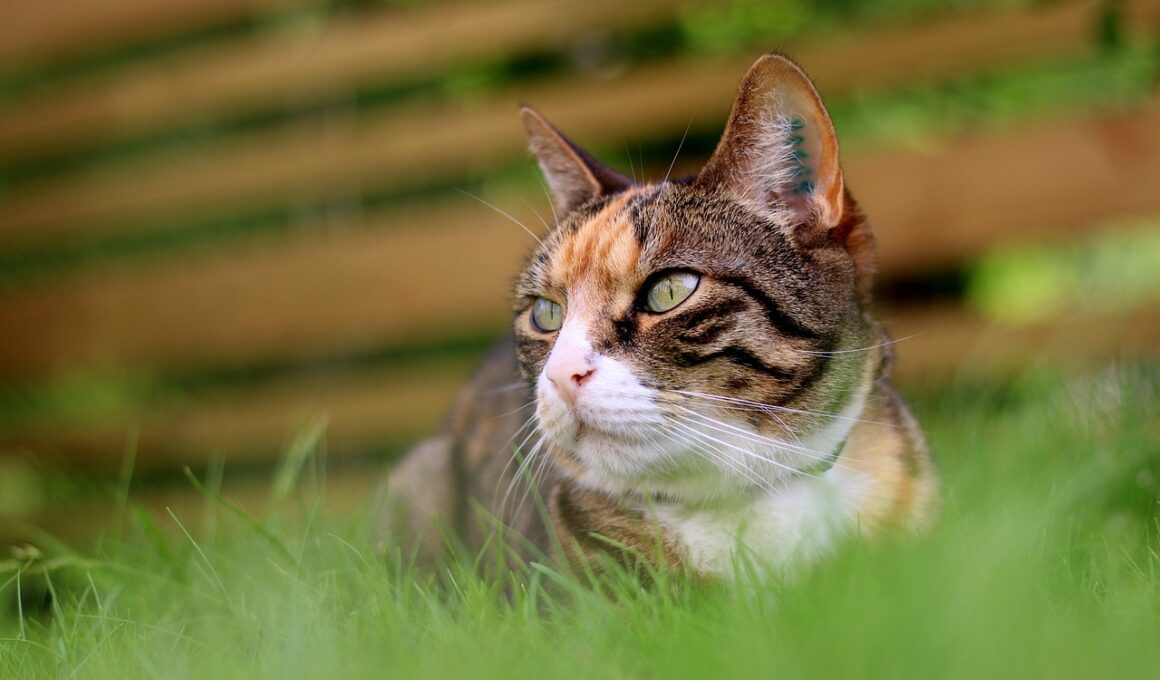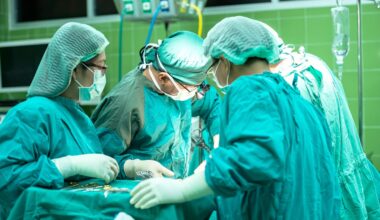How to Help Your Cat Cope with Pain and Stress After Surgery
After surgery, cats can experience pain and stress, requiring attentive post-operative care. Owners can help their feline friends by creating a calm and safe environment. Start by preparing a quiet space away from the hustle and bustle of daily activities. This secluded area should have soft bedding, ensuring maximum comfort. Use familiar items such as toys and blankets to make your cat feel secure. Monitoring your cat’s behavior is essential, as subtle changes often indicate discomfort or stress. If your cat seems disoriented or shows signs of pain, contact your veterinarian immediately. They can reassess the situation and prescribe necessary medications. Furthermore, providing nutritious food and fresh water will contribute to recovery. Offer small, digestible meals to ease the transition post-surgery. Pay close attention to the surgical site, ensuring it remains clean and dry. If any redness or swelling occurs, consult your vet. During the healing process, handle your cat gently and avoid forcing activity. Instead, encourage rest and relaxation, permitting your cat to recover and regain strength gradually. This approach significantly aids in restoring their emotional and physical well-being.
The importance of monitoring pain levels closely cannot be overstated. Owners should familiarize themselves with behavior changes that signal pain. For example, cats may vocalize differently or exhibit changes in grooming habits. Some might become more reclusive or clingy, seeking reassurance from their owners. Using a feline pain scale can help assess their discomfort, thus making it easier to communicate with your veterinarian. Make sure to administer any prescribed pain relief on schedule and monitor effects closely. Effective communication with your vet fosters a better understanding of your cat’s needs. If you notice any unusual behavior patterns, report them as soon as possible. Additionally, consider utilizing calming products such as pheromone diffusers or sprays, which help reduce anxiety. Creating an environment filled with soothing sounds also proves beneficial; soft music or white noise can mask any startling outside sounds. Remember to limit visitors during the recovery period, allowing your cat to recuperate peacefully. Consistency in daily routines reassures cats, helping to minimize their stress levels. When maintaining stability, encourage them to eat and drink without forcing. A calm atmosphere enhances your cat’s healing journey significantly.
Providing Emotional Support
Emotional support plays a vital role in helping your cat recover after surgery. After the procedure, your cat might feel mysterious changes regarding their body and health. To alleviate their anxiety, spend quality time together daily. Gradually resume indoor playtime and interaction as they heal—this connection builds trust and provides a sense of security. Use gentle voice tones to communicate affection and comfort. Also, engaging in slow petting can show your cat that they are safe. Be vigilant about their mood and body language; understanding these cues will strengthen your bond. If your cat enjoys being carried, try using a soft blanket for brief sessions. However, avoid any movements that strain the surgical site. Introducing interactive toys post-surgery can also help distract them from discomfort gently. Furthermore, consider creating a designated playtime routine, offering them predictability during recovery. Encourage socialization through quiet interaction with other pets, ensuring their comfort. Always monitor their reactions, adapting interactions accordingly. All these efforts contribute positively to your cat’s emotional well-being and foster healing. By being compassionate and attentive, your cat will feel cherished during this challenging time.
Maintaining a proper diet is crucial for your cat’s recovery journey. After surgery, they may experience changes in appetite or routine. Start by offering smaller, more frequent meals rather than their usual portions to encourage eating without overwhelming them. Consult your veterinarian about possible dietary adjustments suitable for post-operative care. Ensure access to fresh water at all times, as hydration is essential for recovery. Additionally, how you present food matters; consider warming their meals slightly to enhance aroma and palatability. Dishes should be placed in an easily accessible area, ensuring minimal movement. Cats also appreciate variety, so after a lawsuit, you might introduce different flavors or textures as long as they agree with their dietary needs. Watch closely for any signs of nausea or reluctance to eat, which may suggest complications. Continue monitoring their weight, adjusting food quantities based on their preferences and energy levels. Nutritional supplements might also be beneficial to strengthen their immune system. Always discuss with your veterinarian before making any changes to ensure they align with their recovery plan. A well-balanced diet nurtures their healing journey tremendously.
Gentle Handling and Care
Handling your cat delicately during recovery is essential for their overall comfort. Many cats can feel vulnerable after surgery due to heightened sensations and a new physical state. To ease any discomfort, it’s recommended to create a peaceful atmosphere with minimal disturbances. Avoid sudden movements or loud noises that may startle them, maintaining a calm presence around your cat. When interacting, follow their cues by allowing them to approach you first. During this time, gentle touch can reassure them and strengthen your bond. Be particularly cautious when assisting them to move or reposition themselves, supporting their body without applying pressure. If your cat enjoys being held, consider using a soft blanket or pillow for added support. During grooming sessions, use a soft-bristled brush or your hands to avoid causing any pain. Encourage their natural instincts to rest, lying comfortably without interruption. If they attempt to groom themselves, monitor closely to ensure they do not disturb the surgical site. Your care and attention will significantly improve their recovery process, ensuring they regain strength while feeling secure in your presence.
Paying attention to your cat’s health monitoring during recovery is crucial. Regular observations can help detect any complications early on, such as infections or unusual behaviors. Keep a close watch on the surgical site, looking for signs of redness, swelling, or discharge. If any abnormalities arise, don’t hesitate to reach out to your vet for advice. In addition to physical healing, emotional aspects also require attention. Ensure your cat remains mentally engaged through gentle interactions and sensory enrichment during this period. Introducing safe toys or puzzles can stimulate their curiosity, keeping them occupied without stressing them. Familiar scents from home can minimize anxiety and help maintain a sense of security. Participating in ambient sounds or scents that they love can provide comfort, reinforcing their emotional state. Consult your veterinarian on suitable activities or mental exercises tailored to your cat’s condition. This collaborative care approach fosters a nurturing environment for their recovery. Keeping an open dialogue with your vet ensures you’re equipped with the best insights for your companion’s needs, making the healing journey smoother and more enjoyable.
Long-term Recovery Considerations
A successful recovery process extends beyond the immediate post-operative period. It’s essential to create an ongoing support plan tailored to your cat’s unique recovery needs. Start by setting up regular follow-up appointments with your veterinarian to monitor healing progress. After surgery, frequent vet visits allow for tailored adjustments to treatment plans and medication. Additionally, mapping out activity scales helps ensure your cat resumes normal functioning without undue stress or strain. Gradually reintroduce regular routines, encompassing regular playtime and socialization. Offering structured activities each day helps your cat regain confidence and physical strength. Promote gentle exercise and mobility to boost circulation and support muscle recovery. Remember, patience is key in this process; avoid rushing their healing stages. Implementing gentle stretches or supervised play helps maintain physical health. If your cat expresses a desire for play or interaction, take cues from their behavior. Acknowledge their feelings and comfort levels, adjusting meditation schedules as needed. As your cat slowly returns to normalcy, ensure their environment remains calm and considered, giving them ample time for full recovery. Your ongoing support is vital for restoration.
Engaging with your veterinarian during your cat’s recovery is paramount. Their expertise helps guide you through the healing process while addressing any concerns you may have. Open channels of communication ensure that you’re both aligned in approaches. Don’t hesitate to reach out with questions or uncertainties, especially if you notice changes in behavior or complications. Being proactive can prevent minor issues from escalating and allows for adjustments to be made swiftly. Empower yourself by keeping a log of your cat’s eating habits, activities, and any behavioral changes. This data can be invaluable during vet check-ups highlighting progress and areas needing more attention. In addition, educational resources on feline recovery can provide further insights into proper care techniques and emotional support methods. Understanding your cat’s specific needs fosters an environment for optimal healing. Consider joining online communities or discussions surrounding post-surgery care, enabling you to gain insights from fellow cat parents. The combination of veterinary guidance and peer support strengthens your capability to provide better care. Your commitment to their well-being shines through, aiding their journey toward full recovery. With a supportive plan, your cat will flourish.


